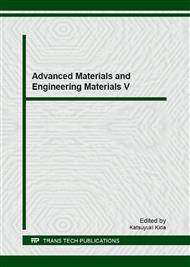[1]
S. Harzallah1,M. Chabaat, S. Benissad, Inverse Problems using Neural Networks for Cracks Characterization in Materials, International Journal of Key Engineering Materials. Vol 660 (2015) pp.361-365.
DOI: 10.4028/www.scientific.net/kem.660.361
Google Scholar
[2]
P. Horan, P. R. Underhill, and T. W. Krause, Pulsed eddy current detection of cracks in F/A- 18 inner wing spar without wing skin removal using modified principal component analysis, NDT&E International, 55, 21-27 (2013).
DOI: 10.1016/j.ndteint.2013.01.004
Google Scholar
[3]
Garcia-Martin, J., Gomez-Gil, J. and Vazquez-Sanchez, E; Non-Destructive Techniques Based on Eddy Current Testing, Sensors, 2011, vol. 11, no. 3, pp.2525-2565.
DOI: 10.3390/s110302525
Google Scholar
[4]
P. F. Horan, P. R. Underhill, T. W. Krause. Real time pulsed eddy current detection of cracks in F/A-18 inner wing spar using discriminant separation of modified principal components analysis scores, IEEE Sensors . Journal, Aug. 27, (2013).
DOI: 10.1109/jsen.2013.2281368
Google Scholar
[5]
M. Rachek,M. Feliachi . 3-D movement simulation techniques usingFE methods: Application to eddy current non-destructive testing, NDT&E International, vol. 40, No. 1, p.35–42, (2007).
DOI: 10.1016/j.ndteint.2006.07.008
Google Scholar
[6]
S. Bennoud, M. Zergoug . Modeling and Simulation for 3D Eddy CurrentTesting in Conducting Materials International Journal of Mechanical, Aerospace, Industrial and Mechatronics Engineering Vol: 8 No: 4, (2014).
Google Scholar
[7]
Chen, L.; Wang, J.; Nair, S.S. An analytical method for predicting 3D eddy current loss in permanent magnet machines based on generalized image theory , IEEE Transactions on Magnetics, Year: 2015, Volume: PP, Issue: 99.
DOI: 10.1109/tmag.2015.2500878
Google Scholar
[8]
Albertz, D.; Henneberger, G. Calculation of 3D eddy current fields using both electric and magnetic vector potential in conducting regions IEEE Transactions on Magnetics, Year: 1998, Volume: 34, Issue: 5.
DOI: 10.1109/20.717612
Google Scholar
[9]
Ren, Z.; Ida, N. Solving 3D eddy current problems using second order nodal and edge elements IEEE Transactions on Magnetics, Year: 2000, Volume: 36, Issue: 4.
DOI: 10.1109/20.877555
Google Scholar
[10]
S. Harzallah ,M. Chabaat , S. Benissad, Formulation for Stress Intensity Factors and J-Integral Calculation byEddy Current Testing , InternationalJournal of Key Engineering Materials. Vol 660 (2015) pp.225-230.
DOI: 10.4028/www.scientific.net/kem.660.225
Google Scholar


